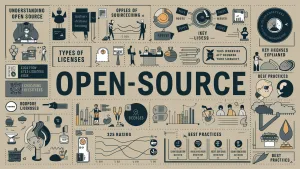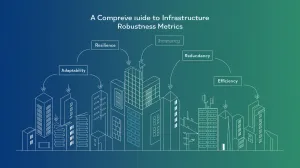

With the right license, you can protect your open-source project and ensure proper usage. This article provides a clear overview of open-source licensing for developers and users.

Open-source software has revolutionized the tech industry, fostering collaboration, innovation, and accessibility. At the heart of this movement lies open-source licensing – a legal framework that governs the use, modification, and distribution of software code. Understanding these licenses is crucial for both developers creating open-source projects and users incorporating them into their own work.
Open-source licenses aren't just legal jargon; they are the backbone of the open-source ecosystem. They define the rights and obligations of both creators and users, ensuring that the software remains accessible, collaborative, and aligned with the principles of openness and sharing.
Open source licenses can be broadly categorized into two main types:
Permissive licenses offer the most freedom to users. They allow the software to be used, modified, and distributed for any purpose, including commercial use, with minimal restrictions. The main requirement is usually to give credit to the original authors.
Copyleft licenses impose stricter conditions on the use and distribution of open-source software. They require that any modified versions of the software be released under the same license, thus preserving the open-source nature of the work.
Let's break down some essential terms you'll encounter in open-source licenses:
The MIT License is one of the most straightforward and permissive open-source licenses. It grants users broad rights to use, modify, and distribute the software, even for commercial purposes.
How to Use: Since the MIT License allows for commercial use, you can incorporate the software into your own product or service and sell it without any restrictions. You only need to include the original copyright and license notice with your distribution.
The Apache License 2.0 is another popular permissive license that offers similar freedoms as the MIT License. It also includes a patent grant, providing additional protection against patent infringement claims.
How to Use: You can use Apache-licensed software in your commercial products or services without any restrictions. You need to include the original copyright and license notice, as well as any modifications you've made.
The GNU General Public License (GPL) is a strong copyleft license that protects users' freedom to use, study, share, and modify software.
How to Use: If you use GPL-licensed software, you must make the source code available to anyone who receives it, even if you sell it. You must also allow them to modify and redistribute the software under the same GPL terms.
The LGPL 3.0 is a "weaker" copyleft license compared to the GPL. It allows you to link your proprietary software to LGPL-licensed libraries without having to release your entire codebase under the LGPL.
How to Use: You can incorporate LGPL-licensed libraries into your proprietary software and sell it. However, you must make the library's source code available to your customers and allow them to modify it. You also need to ensure that any changes you make to the library are released under the LGPL.
The MPL 2.0 is a balanced license that allows for commercial use but requires that modifications to the original source code be shared under the same license.
How to Use: You can use MPL-licensed software in your commercial product, but you must make the source code of any files you modify available under the MPL. This allows other developers to benefit from your changes.
The Eclipse Public License 2.0 (EPL 2.0) is a business-friendly open-source license designed to facilitate commercial adoption while still promoting collaboration and contribution to the open-source community.
How to Use: If you modify an EPL-licensed module and distribute that modified module, you must make the source code of your modifications available under EPL 2.0.
The GNU Affero General Public License version 3 (AGPLv3) is a strong copyleft license designed for software offered over a network.
How to Use: If you modify AGPLv3 software and make it available to others over a network, you must also make your source code modifications available to those users.
BSD (Berkeley Source Distribution) licenses are a family of permissive free software licenses. It allows you to freely use, modify, and distribute software, even for commercial purposes, with minimal restrictions.
How to Use: The main requirement is to include the original copyright notice and the license text in your distribution. You are not obligated to share modifications or source code.
By understanding the nuances of different open-source licenses and exploring various business models, you can leverage open-source software to create profitable products and services while contributing to the open-source community.
Selecting the proper open-source license is a critical decision that depends on your project's goals and the level of control you want to maintain over its use. Consider the following factors:
Let's explore some common scenarios and the suitable licenses for each:
When incorporating open-source software into your own project, be mindful of the following:
You've created an innovative open-source software solution for securing back-end infrastructure. It includes tools for vulnerability scanning, intrusion detection, and threat intelligence. Your goal is to make it widely adopted by businesses and organizations of all sizes while also allowing for potential commercial opportunities.
Based on these considerations, Apache License 2.0 emerges as a strong contender. Here's why:
Another option could be the MIT License. It offers similar permissiveness to Apache 2.0 but lacks the explicit patent grant. This might be a simpler choice if patent concerns are not a major factor for your project.
By choosing the right license, you can foster a thriving community, encourage its widespread adoption, and create a sustainable model for both open-source collaboration and commercial success.
Open-source licensing is a vital aspect of the open-source ecosystem. By understanding the different types of licenses, their use cases, and the key terms involved, you can make informed decisions about which software to use and how to license your own projects. Remember, choosing the proper license can foster collaboration, protect your work, and ensure that your software is used in a way that aligns with your goals and values.

Cybersecurity shouldn't be shrouded in jargon. This article explores the art of translating tech, empowering you to create accessible cybersecurity content that resonates with audience
Sep 16, 2024 4 min read
Infrastructure robustness is critical for ensuring the resilience and reliability of your systems. This comprehensive guide explores key metrics used to assess and improve infrastructure robustness.
Sep 12, 2024 3 min read
Navigating the world of SOC 2 compliance can seem daunting for startups. This article breaks down the complexities, explaining what SOC 2 is, why it's important, and how your startup can achieve and maintain compliance without breaking the bank or slowing down growth.